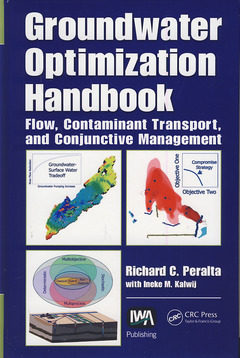Description
Groundwater Optimization Handbook
Flow, Contaminant Transport, and Conjunctive Management
Author: Peralta Richard C.
Language: English
Subject for Groundwater Optimization Handbook:
Keywords
Pumping Strategy; Optimal Pumping Strategy; S/O Computation; Op; Groundwater; Optimization Problem Formulation; Groundwater Problems; Candidate Wells; Groundwater Systems; EWs; Groundwater Optimization; Total Pumping; S-O models; Pumping Block; conjunctive water management; CH CH CH CH CH; contaminant transport; Potentiometric Surface; groundwater flow; NLP Problem; groundwater management; Pumping Extraction; simulation–optimization modeling; Hydraulic Conductivity; simulation–optimization model; TCE Plume; simulation and optimization of water; MINLP Problem; simulator calibration; Pumping Rates; monitoring network design; Scenario 1a; hydraulic optimization; Robustness Range; transport optimization; Optimization Problem Types; conjunctive use optimization; Stream Depletion; groundwater hydraulic optimization; NAFB; contaminant transport optimization; Grand Prairie; Cleanup Zones; Robustness Optimization; Multiobjective Optimization
474 p. · 15.6x23.4 cm · Hardback
Description
/li>Contents
/li>Readership
/li>Biography
/li>
Existing and impending water shortages argue for improving water quantity and quality management. Groundwater Optimization Handbook: Flow, Contaminant Transport, and Conjunctive Management helps you formulate and solve groundwater optimization problems to ensure sustainable supplies of adequate quality and quantity. It shows you how to more effectively use simulation-optimization (S-O) modeling, an economically valuable groundwater management tool that couples simulation models with mathematical optimization techniques.
Written for readers of varying familiarity with groundwater hydrology and mathematical optimization, the handbook approaches complex problems realistically. Its techniques have been applied in many legal settings, with produced strategies providing up to 57% improvement over those developed without S-O modeling. These techniques supply constructible designs, planning and management strategies, and metrics for performance-based contracts.
Learn how to:
- Recognize opportunities for applying S-O models
- Lead client, agency, and consultant personnel through the strategy design and adaptation process
- Formulate common situations as clear deterministic/stochastic and single/multiobjective mathematical optimization problems
- Distinguish between problem nonlinearities resulting from physical system characteristics versus management goals
- Create an S-O model appropriate for your specific needs or select an existing transferrable model
- Develop acceptable feasible solutions and compute optimal solutions
- Quantify tradeoffs between multiple objectives
- Evaluate and adapt a selected optimal strategy, or use it as a metric for comparison
Drawing on the author?s numerous real-world designs and more than 30 years of research, consulting, and teaching experience, this practical handbook supplies design procedures, detailed flowcharts, solved problems, lessons learned, and diverse applications. It guides you through the maze of multiple objectives, constraints, and uncertainty to calculate the best strategies for managing flow, contamination, and conjunctive use of groundwater and surface water.
Ancillary materials are available from the Downloads tab on the book page at www.crcpress.com.
Introduction to S-O Concepts: Essence of Optimizing Groundwater Management. Introduction to Mathematical Optimization for Groundwater Strategy Design. Optimization Theory: Optimization Problem Types and Categories. Deterministic Optimization. Optimization with Uncertainty. Multiobjective Optimization Approaches. Exact and Approximation Simulator Theory: Embedded Numerical and Analytical Equations. Response Matrix Simulators. Approximation and Other Simulators. S-O Processes and Guidance: Formulating Optimization Problems and Selecting S-O Tools. Preparing Data Input and Implementing S-O Tool. Groundwater and Conjunctive Management S-O Application Guidance. Groundwater Contamination and Transport Management S-O Application Guidance. Applications: Hydraulic S-O Modeling Applications. Contaminant Transport S-O Modeling Applications. Closure. Glossary. Index.
Richard Peralta, PhD, PE, has used S-O modeling to design strategies for more than 20 sites or real-world projects. As a Utah Cooperative Extension Service water quality coordinator, he optimized nonpoint and point source contamination management, and collaborated with state and federal agencies in technology transfer and public education. Through the University of Arkansas, and subsequently Utah State University, private work, and the U.S. Air Force Reserve, he worked in 25 U.S. states and in numerous countries. For the military, he participated in and led many environmental contamination remediation evaluation teams and helped provide optimal solutions that were successfully implemented in the field. After several years of advising on environmental matters in the Pentagon, Colonel Peralta retired from the U.S. Air Force Reserve as a chief bioenvironmental engineer. He is a professor in the Civil and Environmental Engineering Department at Utah State University, consults privately, and is the distributor of SOMOS software. For more information, see Dr. Peralta’s page at the College of Engineering at Utah State University.
Contributing author Ineke M. Kalwij, PhD, PEng, collaborates with Dr. Peralta, working on groundwater optimization software development and publications. She also provides consulting services to clients, primarily in the area of groundwater system management. For more information, see Kalwij Water Dynamics Inc.




